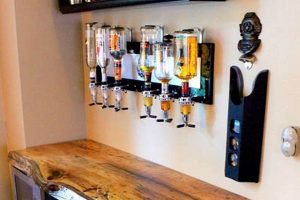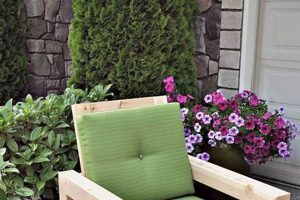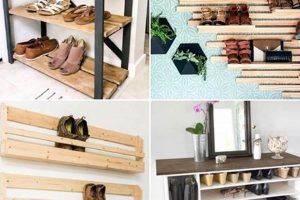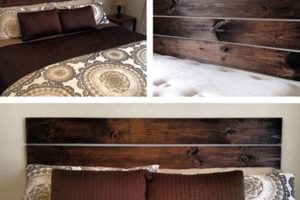The concept refers to creative and practical solutions for protecting the kitchen wall area behind a sink or stove, accomplished through self-directed projects. It encompasses a range of materials, designs, and installation techniques employed by homeowners to personalize and enhance their kitchen space while safeguarding against spills and splatters.
Properly executed projects add significant value to a home by increasing its aesthetic appeal and functionality. Historically, protective coverings in kitchens were purely utilitarian, but modern interpretations combine practicality with design, allowing for self-expression and cost-effective renovation. They contribute to easy cleaning and maintenance, preventing lasting damage from everyday kitchen activities.
The following sections will delve into specific material options, installation methods, design considerations, and relevant resources for planning and implementing such enhancements within the home.
Essential Considerations for Kitchen Wall Protection Projects
Effective execution requires careful planning and attention to detail. The following recommendations outline crucial considerations for achieving a durable and aesthetically pleasing result.
Tip 1: Material Selection: Prioritize materials resistant to moisture, heat, and grease. Options include ceramic tile, glass, stainless steel, and certain types of natural stone. Consider the kitchen’s existing design and choose materials that complement the overall aesthetic.
Tip 2: Surface Preparation: Ensure the wall surface is clean, dry, and free of imperfections. Repair any cracks or holes and apply a suitable primer to promote adhesion. Proper preparation is critical for a long-lasting installation.
Tip 3: Accurate Measurements: Precise measurements are essential to avoid material waste and ensure a professional finish. Double-check all dimensions before cutting materials and allow for expansion joints, particularly with tile installations.
Tip 4: Adhesion and Grouting: Utilize high-quality adhesive specifically formulated for the chosen material and substrate. Follow manufacturer instructions carefully. When grouting, select a grout color that complements the material and seal it properly to prevent staining and moisture penetration.
Tip 5: Proper Tools and Safety: Employ appropriate tools for cutting, installing, and finishing materials. Wear safety glasses and gloves to protect against injury. If using power tools, ensure they are in good working order and operated according to safety guidelines.
Tip 6: Layout Planning: Before beginning installation, carefully plan the layout to ensure a balanced and visually appealing design. Consider the placement of focal points, such as decorative tiles or patterns, and ensure they are centered and aligned correctly.
Tip 7: Sealing and Maintenance: Apply a sealant to protect the material from stains and damage. Regularly clean the surface with a mild detergent and avoid abrasive cleaners that can scratch or dull the finish. Promptly address any spills or splatters to prevent permanent staining.
Adherence to these guidelines will contribute to a successful and enduring result, enhancing both the functionality and visual appeal of the kitchen.
The subsequent sections will provide detailed information on specific design ideas and further resources to aid in project planning.
1. Material Durability
Material durability is a paramount consideration when selecting solutions for kitchen wall protection, directly impacting longevity, maintenance requirements, and overall value. Its inherent resistance to heat, moisture, staining, and physical impact determines the long-term success of the installation. Choosing materials suited to the demands of a kitchen environment minimizes the need for frequent repairs or replacements.
- Moisture Resistance
Kitchen areas are inherently prone to moisture exposure due to cooking, cleaning, and dishwashing activities. Materials selected should exhibit high resistance to water absorption to prevent swelling, warping, or the growth of mold and mildew. Ceramic tile, porcelain, and certain types of sealed natural stone are examples of moisture-resistant options. Failure to consider moisture resistance can result in significant structural damage over time.
- Heat Resistance
Proximity to cooking surfaces necessitates materials capable of withstanding elevated temperatures without degradation or discoloration. Materials like glass, stainless steel, and heat-resistant tiles are frequently employed due to their thermal stability. Using materials with low heat resistance may lead to cracking, melting, or the release of harmful fumes.
- Stain Resistance
Kitchen environments are susceptible to staining from food splatters, grease, and other cooking byproducts. Materials that are non-porous and easily cleanable are ideal for minimizing staining and simplifying maintenance. Options include glazed ceramic tile, glass, and stainless steel. Porous materials, such as unsealed natural stone, require regular sealing to prevent permanent staining.
- Impact Resistance
Accidental impacts from pots, pans, or other kitchen utensils can damage wall protection. Materials with high impact resistance, such as thicker tiles or stainless steel, are recommended for high-traffic areas. Brittle materials, such as certain types of glass or thin ceramic tiles, are more susceptible to cracking or chipping under impact.
The selection of materials directly affects the long-term performance and aesthetic appeal. By prioritizing durable materials that withstand the rigors of a kitchen environment, homeowners can ensure a lasting and visually appealing wall protection solution that minimizes maintenance and maximizes value. Careful consideration of these factors is essential for a successful outcome.
2. Installation Ease
Installation ease represents a pivotal factor in the success and accessibility of self-directed kitchen renovation projects. This consideration significantly influences the feasibility and overall satisfaction associated with choosing various options for wall protection in the kitchen environment.
- Material Weight and Size
The physical properties of materials directly impact the difficulty of handling and securing them. Lightweight, smaller format options, such as peel-and-stick tiles or thin panels, offer simpler manipulation and reduced strain during installation. Conversely, heavier or larger materials, like large-format tiles or slabs of stone, necessitate specialized tools and potentially additional assistance, increasing the complexity and physical demand of the project.
Cutting and Shaping Requirements The ability to easily cut and shape materials to fit the dimensions of the intended space is crucial. Materials that can be readily cut with basic tools, such as utility knives or tile snips, are more amenable to installation. Conversely, materials requiring specialized cutting equipment, like wet saws or angle grinders, introduce a higher level of skill and equipment investment, potentially deterring novice installers.
- Adhesive Application and Curing Time
The method and complexity of adhesive application play a significant role in installation simplicity. Options requiring pre-applied adhesive or simple peel-and-stick mechanisms streamline the process, minimizing the need for mixing and precise application techniques. Materials requiring the application of mortar or thin-set, coupled with extended curing times, demand greater attention to detail and adherence to manufacturer instructions.
- Substrate Preparation Needs
The degree of surface preparation required before installation can significantly influence the time and effort involved. Options that can be applied directly to clean, smooth surfaces offer a simpler installation process. Conversely, materials requiring extensive surface leveling, patching, or priming increase the project’s complexity and potentially necessitate specialized skills or tools.
The choice of a wall protection system should carefully weigh installation ease against desired aesthetics and durability. Projects requiring minimal specialized skills and equipment are more likely to be successfully completed by homeowners, fostering a sense of accomplishment and cost savings. Conversely, attempting complex installations without adequate preparation or expertise can lead to unsatisfactory results and potential rework.
3. Design Versatility
Design versatility, as a characteristic of kitchen wall protection options, directly impacts the breadth of aesthetic choices available to homeowners undertaking self-directed projects. The range of colors, patterns, textures, and material combinations that a particular approach offers determines its adaptability to diverse kitchen styles and personal preferences. Limited design versatility restricts customization, potentially leading to a generic or mismatched final result. Conversely, a high degree of design versatility empowers homeowners to create a truly unique and personalized kitchen space. For instance, a homeowner might choose a simple subway tile layout for a classic, minimalist kitchen or opt for a mosaic pattern with colorful glass tiles for a more eclectic design.
The availability of different material finishes, such as matte, glossy, or textured surfaces, further contributes to design versatility. Matte finishes can create a subtle, understated look, while glossy finishes can add reflectivity and visual interest. Textured surfaces can introduce tactile elements and depth to the design. Consider a homeowner seeking to replicate a rustic farmhouse aesthetic. The selection of distressed wood planks or textured stone-look tiles allows them to achieve the desired ambiance, demonstrating the functional benefits of design flexibility.
Ultimately, design versatility enables homeowners to harmonize the backsplash with existing kitchen elements, such as countertops, cabinets, and flooring, ensuring a cohesive and visually appealing space. A diverse range of design options empowers homeowners to translate their personal vision into reality, resulting in a kitchen that is both functional and aesthetically pleasing. Failure to adequately consider the design limitations during project planning may lead to dissatisfaction with the final result and a failure to achieve the desired aesthetic goal.
4. Cost-effectiveness
Cost-effectiveness constitutes a significant determinant in the realm of self-directed kitchen wall protection projects. The financial implications of material selection, installation methodologies, and long-term maintenance exert considerable influence on decision-making. Projects characterized by low initial expenditure, minimal labor costs, and reduced ongoing maintenance are generally favored. For instance, the installation of peel-and-stick tiles, while potentially less durable than premium materials, presents a cost-effective alternative for homeowners operating within stringent budgetary constraints. Conversely, the selection of expensive materials, such as marble or hand-painted tiles, necessitates a larger upfront investment but may offer enhanced longevity and aesthetic appeal, impacting the overall value proposition.
The ability to mitigate expenses through self-installation directly contributes to cost-effectiveness. By circumventing professional labor costs, homeowners can reallocate resources toward higher-quality materials or supplementary kitchen enhancements. However, this approach necessitates a realistic assessment of one’s skill level and available time to avoid costly errors or the eventual need for professional intervention. Consider a scenario in which a homeowner attempts a complex tile installation without prior experience, resulting in uneven grout lines and misaligned tiles. The subsequent cost of hiring a professional to rectify these errors may negate the initial savings achieved through self-installation.
In summary, cost-effectiveness in relation to self-directed kitchen wall protection projects involves a multifaceted evaluation of material costs, installation labor, and long-term maintenance considerations. A balanced approach that prioritizes both budgetary constraints and the long-term value proposition is essential for achieving a satisfactory and fiscally responsible outcome. While low-cost options may appear attractive initially, a thorough assessment of durability and potential maintenance requirements is crucial to prevent unforeseen expenses in the future.
5. Maintenance needs
The long-term viability of any self-directed kitchen wall protection project is intrinsically linked to the ongoing maintenance requirements associated with the chosen materials and installation techniques. Maintenance needs directly impact the overall cost of ownership, the sustained aesthetic appeal, and the longevity of the installation. Neglecting these factors can lead to premature degradation, costly repairs, and dissatisfaction with the final result.
- Material Cleanability and Stain Resistance
Different materials exhibit varying degrees of resistance to staining, grease accumulation, and general soiling. Porous materials, such as unsealed natural stone, require frequent sealing and specialized cleaning agents to prevent staining and maintain their appearance. Non-porous materials, such as glass or glazed ceramic tile, offer easier cleaning and require less frequent maintenance. The selection of materials with inherent stain resistance significantly reduces the time and effort required for routine cleaning.
- Grout Maintenance and Sealing
In tiled installations, grout lines are particularly susceptible to staining and mildew growth. Regular cleaning with appropriate cleaning solutions is essential to prevent
discoloration and maintain a sanitary surface. Applying a sealant to the grout lines provides an additional layer of protection against moisture penetration and staining. Neglecting grout maintenance can lead to unsightly discoloration, structural damage, and the need for costly grout replacement. - Sealer Application and Reapplication Frequency
Many natural stone and porous tile options require the application of a sealant to protect against moisture absorption and staining. The frequency of reapplication varies depending on the type of sealant used and the level of exposure to moisture and grease. Failing to reapply sealant as recommended can compromise the material’s protective barrier, leading to staining, water damage, and premature degradation.
- Repair and Replacement Considerations
Accidental damage, such as chips, cracks, or scratches, can occur over time, necessitating repair or replacement. The ease with which repairs can be made or individual components can be replaced significantly impacts long-term maintenance costs. Materials that are readily available and easily repaired or replaced offer a more sustainable and cost-effective solution. Conversely, materials that are difficult to source or require specialized repair techniques can result in significant expenses and inconvenience.
The long-term success of a self-installed wall protection project depends heavily on the diligent adherence to a regular maintenance schedule. By carefully considering the specific maintenance needs of the chosen materials and implementing appropriate cleaning and sealing practices, homeowners can ensure the sustained aesthetic appeal, structural integrity, and overall value of their kitchen space. Ignoring these considerations can lead to a costly and time-consuming cycle of repairs and replacements, ultimately diminishing the benefits of the initial self-directed renovation.
6. Aesthetic appeal
Aesthetic appeal functions as a primary motivator and outcome in the implementation of wall protection projects. The selection of materials, patterns, and installation techniques is significantly influenced by the desire to enhance the visual character of the kitchen. The protective wall covering is no longer solely a functional element but an integral component of the overall design. For example, a kitchen featuring minimalist design may utilize a glass installation to create a clean, modern aesthetic. Conversely, a rustic kitchen may incorporate natural stone to complement the existing architectural elements.
The impact of aesthetic appeal extends beyond mere visual enhancement. A well-designed kitchen increases the home’s overall value and enhances the homeowner’s enjoyment of the space. Carefully selected materials and patterns can create a sense of harmony, balance, and visual interest. A homeowner might choose a subway tile design in a neutral color palette to achieve a timeless and versatile aesthetic. Alternatively, a bolder choice, such as a patterned tile or a vibrant color, can serve as a focal point, adding personality and visual drama. Proper lighting further accentuates the design, contributing to the space’s overall aesthetic.
The connection between aesthetic appeal and the project highlights the convergence of form and function. While the primary purpose of the wall protection is to protect the walls from splashes and stains, the aesthetic considerations transform the space into an appealing feature. Balancing practicality with design is essential to create a functional and visually pleasing kitchen. The aesthetic value, therefore, is not a secondary consideration, but an essential component that contributes to the overall success of the kitchen enhancement, improving its functionality and adding perceived value.
7. Project timeline
The project timeline represents a critical element within self-directed kitchen wall protection projects. It directly influences resource allocation, cost control, and the overall success of the endeavor. A well-defined timeline facilitates efficient task management, prevents delays, and ensures timely project completion. Ignoring the development and adherence to a realistic timeline can lead to increased expenses, frustration, and a compromised final product. For instance, a project involving intricate mosaic tile work demands more time for cutting and installation than a simpler installation of subway tiles. Accurate estimation of these varying task durations is crucial for establishing a viable timeline.
Effective timeline management requires careful consideration of all project phases, including planning, material procurement, surface preparation, installation, and finishing. Each phase should be allocated a specific timeframe based on the project’s complexity and the installer’s skill level. Contingency periods should be incorporated to accommodate unforeseen delays, such as material shortages or unexpected structural repairs. Failure to account for these potential disruptions can result in missed deadlines and project setbacks. Consider a scenario in which a homeowner underestimates the drying time for adhesive. Premature grouting can compromise adhesion and necessitate rework, thereby extending the project timeline and increasing costs. Furthermore, the timeline must align with the homeowner’s availability and other commitments to ensure consistent progress and prevent project stagnation.
In conclusion, the creation and maintenance of a detailed project timeline is indispensable for ensuring the effective implementation of kitchen wall protection projects. It serves as a roadmap, guiding homeowners through each project phase and mitigating potential risks. Adequate time allocation, combined with proactive contingency planning, promotes timely project completion, cost control, and a satisfactory final result. Conversely, disregarding the project timeline leads to inefficiencies, increased expenses, and a compromised outcome.
Frequently Asked Questions
The following addresses common inquiries regarding self-managed kitchen wall surface enhancement projects.
Question 1: What factors determine the appropriate material for a kitchen backsplash?
Selection depends on durability, moisture resistance, heat tolerance, stain resistance, ease of cleaning, and the desired aesthetic. Consideration of the kitchen’s overall design is critical.
Question 2: How is surface preparation relevant to a successful installation?
Proper preparation ensures adequate adhesion and a smooth, uniform surface for the material. This process typically involves cleaning, repairing imperfections, and applying a suitable primer.
Question 3: What tools are commonly required for kitchen wall surface enhancements?
Essential tools include a measuring tape, level, tile cutter (if applicable), notched trowel, grout float, sponges, safety glasses, and gloves. Specific tool requirements vary by material and installation method.
Question 4: How does grout selection affect the long-term performance of tiled surfaces?
Grout selection influences stain resistance, water impermeability, and overall durability. Epoxy grouts offer superior performance compared to cementitious grouts in demanding environments.
Question 5: What safety precautions should be observed during the insta
llation process?
Safety glasses should be worn to protect the eyes from debris. Gloves should be used to protect the hands from adhesives and sharp edges. Adequate ventilation is essential when working with solvents or adhesives.
Question 6: How frequently should sealed surfaces be resealed?
Resealing frequency depends on the type of sealant used and the level of exposure to moisture and grease. Generally, resealing should be performed every one to two years, or as recommended by the sealant manufacturer.
Prudent planning and meticulous execution are critical for successful self-managed enhancements.
The following sections provide guidance on common errors to avoid.
Concluding Remarks on Kitchen Wall Protection Solutions
The preceding sections have examined the multi-faceted considerations integral to the successful implementation of kitchen wall protection projects. Careful planning, informed material selection, adherence to proper installation techniques, and attention to ongoing maintenance are crucial factors influencing the longevity, aesthetic appeal, and overall value of these enhancements.
The efficacy of implementing such projects hinges upon a comprehensive understanding of materials, methods, and potential challenges. It is incumbent upon the homeowner to diligently research and prepare, recognizing that informed decision-making significantly impacts the durability and visual impact of this functional and decorative element within the kitchen environment. Prioritize thoughtful planning and execution to realize the full potential of this endeavor.







